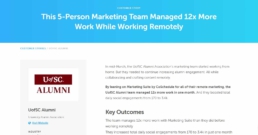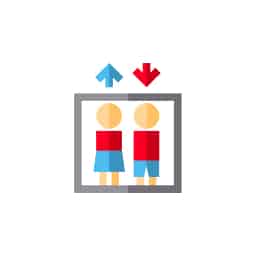How to Write a Case Study - Complete Guide with Examples & Templates
Table of Contents
- What is a Case Study?
- Why You Should Write Case Studies for Your Business
- Different Types of Case Studies
- How to Do a Case Study
- A Few Great Case Study Examples
- Business Case Study Templates You Can Use
- Writing Case Studies Boosts Customer Engagement and Highlights Your Value Proposal
- Small Business Resources for Business & Personal Growth
How to Write a Case Study:
- Determine the objective
- Decide on the type study
- Choose a customer
- Conduct research
- Design a format and structure
- Analyze the data
- Write the case study
- Share the results
In a world where people document everything from daily sunsets to what they had for brunch, you are going to need a lot more than words to sell your business. People want proof – pics, video, documents – and when it comes to business, the proof is in the case study. Along with other essential skills to succeed as an entrepreneur or small business owner, knowing how to write an excellent case study for your company website is an important skill to master to help grow your business and build loyalty among the clients and customers you already have.
LinkedPhone serves the small business community with local & toll-free business numbers that work with your cell phone, desk phone, & laptop. Add a 2nd phone number to your cell phone with our mobile app. Talk & text with clients on the go. Add team members too. Finally break free from the desk phone. At LinkedPhone, freedom rings! 🔔📱💻☎️
What is a Case Study?
A case study for your company website is an inspiring story, a show-n-tell of sorts that lets you highlight what you do best and show in-depth case analysis of a specific situation or event. It is a detailed study that involves examining a variety of factors in order to gain a better understanding of its characteristics.
Case studies are often used in business, education, and research to provide a real-world context to help inform decision making and problem solving. The best case studies are engaging and tell a story that is backed up with data. They are one of several creative ways to get more customers for your small business, such as getting active on social media, supporting your community and creating a good value proposition.
Case studies involve collecting data and analyzing it to gain insight into the topic being studied. The data is collected through interviews, surveys, observations, and reviews of documents and records. Once the data is collected, it is analyzed and interpreted to gain an understanding of the topic. This is usually done through qualitative and quantitative case analysis, which involves looking at the data and determining the key points and trends.
The case study results are synthesized and the case study analysis is presented in a written document or other media. The report will include an analysis of the data, the conclusions, and any recommendations. The report should be easy to understand and provide a clear picture of the situation being studied. It should also provide a basis for further research and analysis.
Why You Should Write Case Studies for Your Business
If you are looking for a great way to promote your business and demonstrate the effectiveness of your products and services, writing a case study is an excellent choice. Case studies can be used to illustrate the positive results of working with your company and how your offerings have helped others. They can be used to demonstrate the value of your product or service, highlight customer success stories, or showcase how your company has helped customers solve problems or achieve their goals.
Case studies are also an effective tool for marketing, as they tell a story about a real customer experience and the results they achieved with your help. They are a great way to bring in new customers and to get more phone leads from your website.
Here are 5 great reasons why you should write a case study for your business:
1. Showcase Your Expertise
Writing a case study allows you to demonstrate your expertise in a particular field or industry. By featuring a successful project or customer success story, you can show potential customers the value of your business and the quality of your products or services.
2. Increase Brand Awareness
A case study is an effective marketing tool that allows you to showcase the success of your business and highlight the unique benefits of your product or service. It is a great way to boost your brand awareness and attract the attention of potential customers. By featuring a customer’s success story, you can demonstrate the value of your business and the benefits of working with you.
3. Build Trust and Credibility
Writing a case study allows you to build trust and credibility with potential customers. Peer testimonials that showcase a successful project or customer success story can demonstrate the reliability of your business and the quality of your services or products.
4. Attract New Customers
A case study is an effective way to draw new customers to your business. By featuring a customer success story, you give potential customers a reason to take note of your business, and can demonstrate the unique benefits of working with you. Case studies catch the eyes of potential clients looking for solutions.
5. Establish Your Brand
Writing a case study is an effective way to establish your brand and position yourself as an authority in your industry. By showcasing a successful project or customer success story, you can demonstrate the value of your business and the unique advantages of working with you.
Different Types of Case Studies
There are several different types of case studies and case study methods that can be used depending on the focus of the research and the resources available to the researcher. Here are some of the most common types of case studies:.
-
- Qualitative - A qualitative case study focuses on the individual or group being studied and involves collecting and analyzing data from a variety of sources.
- Quantitative - A quantitative case study looks at a larger population and involves gathering and analyzing numerical data.
- Descriptive - A descriptive case study is used to describe a phenomenon in detail, such as a particular event or group of people. Descriptive case studies are often used to explore the characteristics of a larger population or to provide a detailed account of an individual or organization.
- Explanatory - An explanatory case study is used to explain why certain events or outcomes occurred. It may also be used to examine the relationship between two or more variables. Explanatory case studies are often used to provide insights into complex phenomena or to test existing theories.
- Exploratory - An exploratory case study is used to explore a phenomenon in depth, often to identify new questions and areas for further research. Exploratory case studies are often used to investigate a problem or issue and to generate alternative solutions.
- Comparative - A comparative case study is used to compare two or more different phenomena. Comparative case studies are often used to explore the similarities and differences between two or more organizations, people, or events.
- Longitudinal - A longitudinal case study is used to study a phenomenon over a period of time. Longitudinal case studies are often used to track changes in an individual or organization over a period of time or to compare different individuals or organizations at different points in time.
- Clinical - A clinical case study is used to investigate a specific health-related issue or condition. Clinical case studies are often used to explore the causes, symptoms, and treatment of a particular disease or disorder.
No matter which type of case study you choose, it is important to remember that the goal is to gain a better understanding of the issue or phenomenon being studied. Each type of case study has its own benefits and drawbacks, so it is important to choose the method that best suits the goals of your research.

How to Do a Case Study
Doing a case study requires a systematic approach. Here are a few steps to get you started:
1. Determine the Objective
Of course you want to showcase your product or service, but think specifically about what element of your business or client objective you would like your case study to highlight. What role will your case study play in your overall marketing strategy?
2. Decide on the Type of Case Study
You should first decide which type of case study best suits your research question or hypothesis. For example, if you are examining a particular event or process, you may opt for an exploratory case study. Alternatively, if you are looking to test an existing theory or hypothesis, you may opt for an explanatory case study.
3. Choose a Customer to Analyze
Choose a customer that has experienced success with your product or service. Consider the customer’s demographics, motivation, and goals in order to create an effective case study. Think also about the audience you are trying to influence, and determine their needs, challenges and goals. Taking some time to flesh out your target customers will help ensure you choose the right customer for your case study.
Once you have an idea of your target audience, look at your list of loyal customers and choose one that is representative of the demographic you are trying to reach. The more their industries, goals and challenges align, the more the case study will resonate with potential customers. Developing a case study for each key customer persona is a great idea. Personalization will go a long way to keeping them engaged and keeping their attention.
4. Conduct Research
Conducting case study research involves gathering data from a variety of sources, including interviews, surveys, and observations. Businesses often base their case studies on customer interviews, but don’t forget to add in data when relevant. If you are conducting an interview, be prepared with questions that will show the customer’s story from the beginning of the challenge in question, to your involvement and the experience of working with you, and finishing with an ending that makes you into the hero of the story.
5. Design a Format and Structure
Choose a case study format and structure for your case study that is engaging and will make it easy for people to understand the main points. Consider multiple ways you can tell your story with different media. Your format doesn’t have to be limited to a written piece of paper, but can take the shape of a video, audio, blog post, landing page or infographic as well.
6. Analyze the Data
Analyzing a case study means digging deep into the data you’ve collected in order to draw meaningful conclusions. This involves looking for patterns and trends in the data and determining what they mean. It is important to consider the implications of the data and to determine how it can be used to answer your research question or hypothesis. Make sure you are using solid, factual data.
7. Write the Case Study
Use clear and concise language to explain the findings and conclusions of your case study. Presenting the case study in the form of a story can be an excellent approach, or you can present the data in short snippets along with visuals such as graphs and charts. Don’t forget to put your case study through edits and revisions, including getting internal feedback from your team as well as customer feedback from the participating customer.
8. Share the Results
Once your case study is complete, it’s time to distribute and promote it with your target audience. You can share it through your website, social media channels, email campaigns, or other marketing venues.
A Few Great Case Study Examples
Taking a look at some effective case study examples can help you get the ideas flowing and start writing your own. Here’s a roundup of a some excellent case studies that illustrate the many approaches and presentations you can choose:
Ideo uses simplicity to introduce viewers to its case study immediately upon entering the website. A big, bold photo announces the title of the case study, and brief snippets detail the main takeaways of the case study in bite-size text. Accompanied by visuals and images to enrich the experience, Ideo successfully engages the viewers while presenting the data that highlights its successes.
Like many businesses, Freshbooks has a diverse audience that they consistently wish to target. An effective case study strategy must take into account the need to publish diverse content that speaks to each segment of your targeted audience. Freshbooks excels at this, featuring brief customer stories from a variety of different businesses and personas who are relatable to various audiences.
This is an example of an incredibly well written and beautifully formatted case study with fast facts that are to the point. The case study breaks down the story into the challenge, the solution, and the results. A brightly-colored graph showcases the impact of the results, and a quote from a key team member drives home the message. Included is a quick-reference bar on the side that details the essential details, provides an option to download a PDF of the case study, and gives a CTA to request a demo.
It is no surprise that one of the most popular business tools would produce highly effective and well-written case studies, and Slack comes through with high scores on this one. This case study about how Shipt delivered faster, higher-quality support for members, shoppers and retailers by using Slack is an excellent example of how a longer, story driven blog post can be an incredibly effective way to deliver content in a memorable and relatable way.

Business Case Study Templates You Can Use
Creating a case study can be time-consuming and challenging, especially if you are new to it. To make the process easier, you can use a case study template. This will help you organize your data and format your case study in a way that will make it easier to read and understand.
A standard case study template may include the following key components:
-
- Title - Describes the essence of the work.
- Introductory Overview - Includes a thesis statement summarizing the outcomes of your analysis.
- The Problem - Details the issue, relevant facts and background information.
- The Solution - Introduce your product or service as a solution and highlight how the customer used it to add value to their situation.
- The Results - Detail the outcome achieved by the customer in a quantifiable way. This can include data and customer testimonials.
- Call to Action - Provide recommendations for next steps for the interested customer or client.
There are 3 main types of business case study templates:
The Problem-Solution Case Study Template
This type of template is used to highlight a problem and then show how you solved it. It can be helpful for showing off your skills and abilities as well as highlighting what makes you unique.
-
- Title - The title should be around 70 characters or less and mention the product or service.
- Introduction - Begin with a short introduction of about 100 words, highlighting the customer who your case study is about, the opportunity the customer saw in your company and success metrics that the customer observed after doing business with you.
- The Problem - Here you can tell in more detail about the customer or business and the problem, challenges or opportunities they were facing before doing business with you.
- The Solution - Show how the customer used your product, detailing precisely how it was implemented in their situation and how it helped the subject overcome their challenges. Add a powerful quote from the customer about why they chose your business.
- Results - Explain where the subject is today as a result of using your product. Use statistics to back your arguments up.
- Call to Action - Inspire the audience to take action with a call to click a link, join a group, download a file, or purchase an item.
The Chronological Case Study Template
This case study template type is used to tell a story about a customer or client in order from beginning to end. This can be helpful for illustrating how you’ve helped someone in the past and what results they achieved.
-
- Title - The title should be around 70 characters or less and mention the product or service.
- History - Start at the beginning, when the customer was in need of your services. Tell the story of where they came from and what the situation was like before your involvement.
- What Happened Next - Tell the story of how the customer chose your product or service, and in what ways they were able to implement it. Give the results of the implementation, including data to back it up.
- Looking Forward - Here you can explain the customer’s future goals and how your product or service will play a part in helping them meet those goals. End with a call to action to inspire your audience to engage with your product or service.
PDF, HTML and PowerPoint Case Study Templates
If you are looking for a more involved template so you can skip spending hours on the design aspect, there are multiple sites that offer drag-and-drop templates in various formats, such as Interactive Pdf, HTML for emails, PowerPoint, PNG and more. Creating a case study can be challenging if you’ve never done it, but taking advantage of pre-designed templates can help you get the information out to the world in a way that is appealing and engaging.
Venngage and SlideUpLift have a great selection of beautifully made templates for a variety of formats, and Template Lab has some great, free Microsoft Word templates to get you started.

Writing Case Studies Boosts Customer Engagement and Highlights Your Value Proposal
Case studies are a great way to engage with customers and prospects and to illustrate the success of your products and services. They can be used to show potential customers the value of working with your company and to build trust and loyalty. They can bring your products and services to life for new customers. By using a systematic approach and following the steps outlined above, you can create an effective case study that will help you reach your goals.
LinkedPhone can help you grow your small business with local and toll-free businesses numbers that save you time and allow you to focus on important details of growing your business, such as writing a case study. Sign up for a 7-day free trial and find out what LinkedPhone can do for your business!
Business Growth Toolkit
Get the latest thought leadership insights on growing your business plus occasional LinkedPhone updates. We respect your inbox!
Small Business Resources
A special high five to Faith Dickens for her outstanding research and contributions to this article. We love working with and supporting like-minded entrepreneurs. Thank you Faith! ❤️
Get In Touch
We would love to hear from you.
Please contact us at any time with questions or feedback.




























